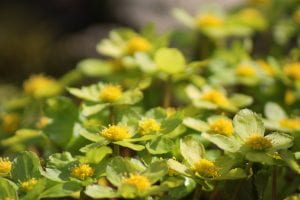By Andy Winfield
 After winter, the ground slowly wakes up in increments; snowdrops and hellebores in January, crocus in February. By March we’re looking up at magnolias and cherries, down at daffodils and forward to longer days and warmer temperatures. The old spring favourites quicken our heartbeat, but I’m going to talk about an understated gem at the Botanic Garden. This is a plant that I look forward to seeing every year; you could easily walk its path without noticing, as it produces flower low to the ground while everyone is looking elsewhere. One of those plants that when you’ve seen it one year you look out for it again, until it becomes like greeting an old friend who always seems happy to see you.
After winter, the ground slowly wakes up in increments; snowdrops and hellebores in January, crocus in February. By March we’re looking up at magnolias and cherries, down at daffodils and forward to longer days and warmer temperatures. The old spring favourites quicken our heartbeat, but I’m going to talk about an understated gem at the Botanic Garden. This is a plant that I look forward to seeing every year; you could easily walk its path without noticing, as it produces flower low to the ground while everyone is looking elsewhere. One of those plants that when you’ve seen it one year you look out for it again, until it becomes like greeting an old friend who always seems happy to see you.
Sanicula epipactis (syn. Hacquetia epipactis) was originally named after Belsazar Hacquet from Carnolia (now Slovenia), a man who lived in the 18th century and was a war surgeon by trade, but had many strings to his bow. He explored the Julian Alps extensively producing a four-volume work on the geology of the region; with an obvious love of his homeland and its nature, he also collected native plant specimens for his herbarium, over 4,000 in total. Of these specimens was Sanicula epipactis, known in Slovenia as the toothed starfish flower, (hvězdnatec zubatý to be precise) appearing in deciduous forests of the Alpine foothills through a few pockets of South East Europe. In winter there is no trace, it dies back to ground level and beyond, staying out of reach from hungry snufflers; you would think nothing is there.
Here in Bristol it wakes up in March, away from all the extravagant spring arrivals elsewhere in the Garden, it flowers incognito; lime green leaf like bracts surround a small yellow inflorescence that stick close to the ground. A plant you have to work to enjoy, first to find it and then to stoop down for a closer look; the green is vibrant, and its habit is perky giving an all-round cheerful disposition that can only make you smile when you see it, just getting on with its own thing in its own way. The flowers are soon joined by verdant leaves which nestle amongst the flowers forming a small jaunty clump. Plants like to feel at home and as a woodland plant Sanicula epipactis enjoys its life in the shadows, my pet name for it is the shady daisy, and a spot not too dry; plant it nice and deep and it’ll think it’s under Slovenian beech. It’s becoming more widely available to buy, and if you have a spot in your Garden that fits the bill I’d recommend it.
As we are looking at the colour around us, nurturing us out of the winter just gone, take a little time to seek out this understated charmer sitting on the ground in the Phylogeny display. Once you see it once, you’ll be seeking it out every year.


Inspirational!
I look forward to learning more & visiting in the future.
Bernadine